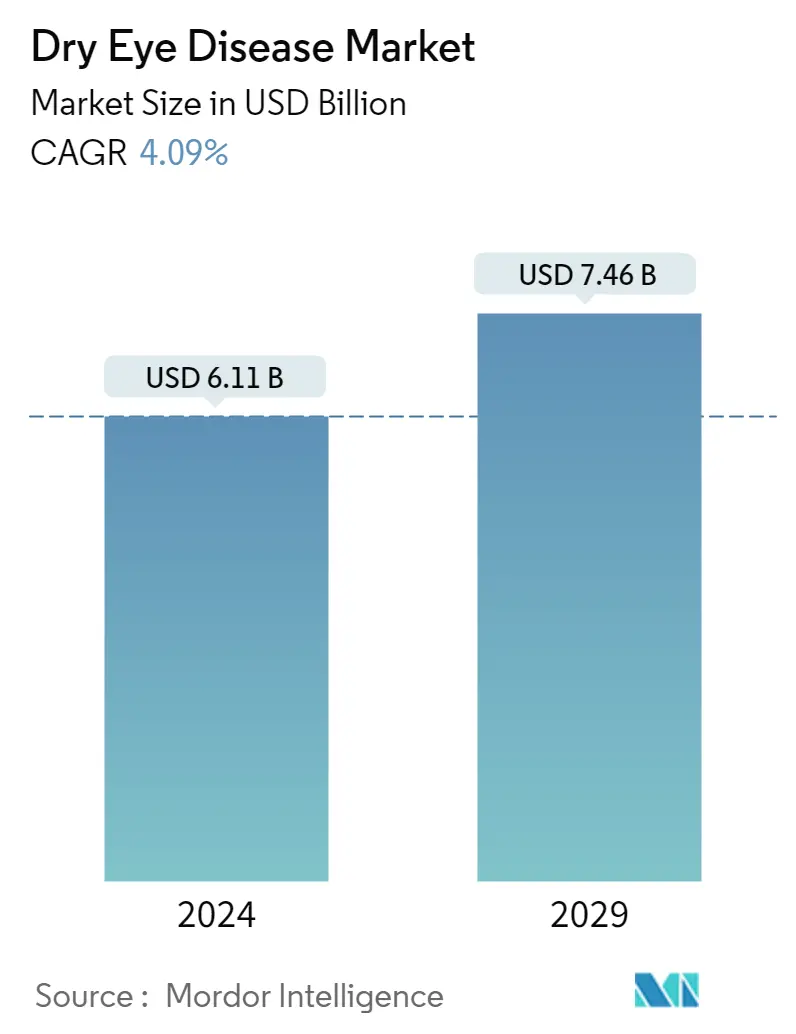Market Size of Dry Eye Disease Industry

| Study Period | 2021 - 2029 |
| Market Size (2024) | USD 6.11 Billion |
| Market Size (2029) | USD 7.46 Billion |
| CAGR (2024 - 2029) | 4.09 % |
| Fastest Growing Market | Asia-Pacific |
| Largest Market | North America |
Major Players
*Disclaimer: Major Players sorted in no particular order |
Need a report that reflects how COVID-19 has impacted this market and its growth?
Dry Eye Disease Market Analysis
The Dry Eye Disease Market size is estimated at USD 6.11 billion in 2024, and is expected to reach USD 7.46 billion by 2029, growing at a CAGR of 4.09% during the forecast period (2024-2029).
The impact of COVID-19 on the dry eye market was adverse in the initial phases owing to the cancellations in elective procedures including diagnosis and eye treatments along with supply chain disruptions of medications worldwide. During the lockdown, people's screen time (irrespective of their age) increased significantly, which had a severe impact, and an increase in ophthalmic disorders was observed. For instance, a research study published in December 2021 stated that both dry eye disease (DED) patients and healthy participants up to the age of 60 experienced worsening dry-eye symptoms during the COVID-19 lockout due to increased visual display terminal (VDT) period. The study also reported that younger persons had more severe dry-eye problems than older respondents, particularly during the lockdown. Therefore, the market gained traction as the restrictions were lifted. Since the pandemic led to an increase in dry eye disease cases globally. Hence, it is expected to propel the market growth during the forecast period.
Several factors, such as aging, decreasing supportive hormones, systemic inflammatory diseases, ocular surface diseases, or surgeries that affect the cholinergic nerves, which stimulate tear secretion, may be associated with the rising prevalence of dry eye-related diseases. For instance, an article published in Frontiers in Medicine Journal stated that among people who require eye care, DED has become the fifth most prevalent ocular condition in women and ninth most prevalent in men in the United States in 2021. Additionally, an article published in the Journal of the British College of Ophthalmic Opticians stated that the global prevalence of dry eye disease was estimated at 11.59% in 2021. Thus, the burden of DED is anticipated to drive the studied market growth in the country.
Furthermore, a research study published in BMC in Opthalmology Journal in May 2021, conducted a survey by 452 participants in Dubai, out of which 63.7% were females. The prevalence of dry eyes in Dubai was estimated to be 62.6% in the surveyed population, with 42% having severely dry eyes. A significant percentage of the global population suffers from dry eye disease. The disease is particularly more common among women than in men. This factor is responsible for propelling the market growth in the analysis period.
The strategic initiatives adopted by the key market players such as product launches, approvals, partnerships is also driving growth. For instance, in November 2021, I-MED Pharma USA launched I-DROP MGD, preservative-free, viscoadaptive eye drop containing a lipid designed to enhance and stabilize all three layers of the tear film to treat dry eye. Such developments are estimated to augment the market growth during the forecast period.
However, the high cost of specialty dry eye products with complex reimbursement scenarios and the availability of alternative therapies are likely to impede the market's growth over the forecast period.
